
Fundy Stamp Collectors Club
c/o 34 Berwick Street
Riverview NB
E1B 5P4
info@fundystampclub.ca

 |
|
 |
|
CAPE HATTERAS LIGHTHOUSE THE WORLDS TALLEST LIGHTHOUSE, ON THE ATLANTIC SHORE OF USA, STANDS AT 208 FEET. IT STANDS WATCH OVER THE "GRAVEYARD OF THE ATLANTIC", IN NORTH CAROLINA. IT WAS BUILT JUST AFTER THE CIVIL WAR, AND IS 135 PLUS YEARS OLD AND HAS SURVIVED A MAJOR EARTHQUAKE AND FORTY SOME HURRICANES. IT WAS CONSTRUCTED OUT OF GRANITE, BRICK, MARBLE, BRASS AND BRONZE AND WEIGHED IN AT 9.6 MILLION POUNDS. THE LAST FULL TIME KEEPER OF THE LIGHTHOUSE LEFT IN 1936. THERE ARE ESTIMATED BETWEEN 600 AND 1000 SHIPS LOST SINCE COLONIAL TIMES ON THE OUTER BANKS OF CAPE HATTERAS. , AT CAPE HATTERAS, THE GULF STREAM TOUCHES THE TIP OF DIAMOND SHOALS, AS IT RUNS NORTH UP THE COAST, THEN TURNS TOWARDS EUROPE. DIAMOND SHOALS HAVE SANDBANKS JUST BELOW THE SURFACE, MILES OUT TO SEA. CAPE HATTERAS LIGHTHOUSE WARNED SAILERS AND CAPTAINS AS TO THEIR LOCATION. THE GULF STREAM RUNS ABOUT FOUR MILES PER HOUR. SHIPS GOING NORTH USED THIS TO THEIR ADVANTAGE. SHIPS GOING SOUTH WOULD USE THE LABRADOR CURRENT, THEN WOULD WAIT AT HATTERAS FOR THE WINDS TO SHIFT SO THEY COULD COMBAT THE GULF STREAM TO GET AROUND THE TREACHEROUS DIAMOND SHOALS. UP TO 50 OR 60 YEARS AGO THERE COULD BE AS MANY AS 150 BOATS WAITING FOR THE WINDS TO SHIFT. CAPE HATTERAS LIGHTHOUSE WAS BUILT BY DEXTER STETSON, AND WAS ERECTED 1800 FEET FROM THE SHORELINE. VERY RECENTLY THE LIGHTHOUSE WAS STANDING 120 FEET FROM THE SHORELINE AND THE DECISION WAS MADE TO MOVE THE LIGHTHOUSE IN LAND TO A NEW LOCATION. IT WAS MOVED 2900 FEET INLAND, WHICH IS APPROX. ONE HALF MILE, AT A RATE OF ONE FOOT PER MINUTE. IT TOOK 23 DAYS TO MOVE THE LIGHTHOUSE. DURING THE MOVE IT WAS KEPT LEVEL AND UPRIGHT BY 100 HYDROLIC JACKS PLACED BENEATH, AND ALL WERE HOOKED UP TO AND RUN BY COMPUTERS. IT WAS PROPELLED THE 2900 FEET DOWN A STEEL TRACK OVER THE BEACH SAND BY FIVE HUGE HYDROLLIC RAMS. THIS AMAZING FEAT WAS COMPLETED WITHOUT MAKING A SINGLE NEW CRACK IN THE CONCRETE OF THE LIGHTHOUSE. IT IS TO BE DECOMISSIONED BY THE US GVT. AND USED AS PART OF THE CAPE HATTERAS PARK. Contributed by Dave Tait. Of Oxford Junction Nova Scotia.
|
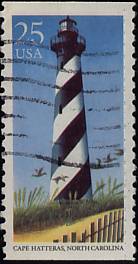
|
|
This stamp is called Church and Horse and was painted in 1964 by Alex Colville. The stamp is from the masterpieces of
Canadian art Series. The church that the painting is from is located in Hastings Nova Scotia.
Which is a small rural community located between Amherst and Oxford Nova Scotia. Alex Colville was born in Toronto in 1920, They moved to Amherst when Alex was 15 years old. He enrolled in fine arts at Mount A University in 1938. He worked as a war artist during WW II, and then taught fine arts at schools and Universities thoughout North America. He also designed centennial coins and the governor generals medal before being made a companion of the Order of Canada in 1982. His art work can be found in collections around the world. The church and horse depicts a wild horse galloping to safety through a churchyard to escape dark rain clouds that threaten overhead. The painting is housed in the Montreal Museum of Fine Arts. Contributed by Dave Tait. Of Oxford Junction Nova Scotia.
|
 Chruch and Horse
The real church
|
|
Charles Proteus Steinmetz (1865-1923) was a brilliant
mathematician and electrical engineer, born in Breslau,
Germany. In college, he earned a reputation for never missing
a class and for being able to master the most difficult
engineering and scientific courses. Steinmetz emigrated to the United States in 1889. His first employer recognized his talents quickly and assigned the young scientist to a laboratory of his own in which to conduct his experiments. At the age of 27, Steinmetz joined the General Electric Company as a consulting engineer, a position he held for the rest of his life. It was at GE that he performed most of his important experiments on alternating currents. At the same time, he served as professor of electrical engineering at Union College, in Schenectady, New York. |
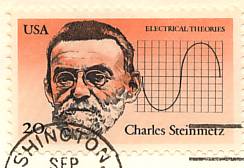 Charles Steinmetz
|
|
Edwin Howard Armstrong (1890-1954) devised his first invention,
the design of circuitry to amplify radio signals,
while attending Columbia University. Later, as an officer in
the U.S. Army Signal Corps during World War I, he designed
the superheterodyne circuit that is still used in radio and
television receivers. By selling the patent rights to his circuits, Armstrong became a millionaire as a young man. He used part of his capital to develop frequency modulation (FM), which makes it possible to receive radio signals in the most violent of electrical storms. |
 Edwin Armstrong
|
|
Philo Taylor Farnsworth (1906-1971) was raised in the small
town of Beaver, Utah. A precocious student, he was only
sixteen when he formulated his idea for transmitting pictures
through the air. Six years later, he received the first of
165 lifetime patents for the systems and components of
television receivers. In addition, he made important contributions
in the design of special-purpose vacuum tubes and
radar systems. Farnsworth showed equal skill as a businessman, forming his own business and later working as a consultant for large corporations. He was elected to numerous scientific and engineering societies in the United States and Europe and received honorary doctorates from many universities. |
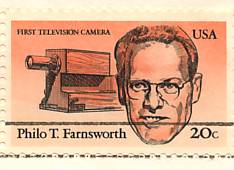 Philo Farnsworth
|
|
Nikola Tesla (1856-1943) was born in Croatia.
A scientific prodigy, he began experimenting
with electric motors during his student days in Austria. In
1884, after his ideas for the use of alternating currents found
little favor in Europe, he emigrated to the United States. In America, Tesla performed important and varied research. His experiments laid the groundwork for the use of electric current in heating and medical therapy, and made possible the world's first hydroelectric plant in Niagara Falls. Tesla also invented a system of arc lighting, in which electric current flows between two electrodes to create a very bright light. Then, in 1917, years before it became an actuality, he outlined the concept of radar to detect submarines under the sea. To honor his contributions to science, Tesla was inducted into the National Inventors Hall of Fame, in Arlington, Virginia, in 1975. |
 Nikola Tesla
|
|
The Brooklyn Bridge, one of New York City's most famous
landmarks, is the most celebrated suspension bridge in the
world. . In 1964,
the Brooklyn Bridge was designated a national historical
landmark. The bridge was designed in 1867 by John A. Roebling, a German born immigrant, who had previously designed shorter spans over the Niagara and Ohio Rivers. When Roebling died two years later, the task of building the Brooklyn Bridge fell to his son, Washington A. Roebling. The giant span, then the longest suspension bridge ever built, took over thirteen years to complete. It was finally opened to traffic on May 24, 1883. Headlines in newspapers around the world heralded the opening of the bridge, which was called the eighth wonder of the world." Its over-water span, from one 275 foot granite tower to the other, measured 1,595.5 feet. The roadway soared 133 feet above the waters of the East River. The bridge could support a total weight of 48,000 tons, much of which was borne by two pairs of woven steel cables, sixteen inches in diameter. One of Roebling's major innovations was the system of cable mountings, which could accommodate the expansions and contractions caused by wind and temperature changes. One of the little known features of the bridge is the wine vault, located deep inside the Manhattan tower. It was added during construction, paid for by a New York department store which kept its imported stock there. When prohibition became the law of the land, the vault was sealed and has never been reopened. Howard Koslow of East Norwich, New York, designed the 20 cent U.S. commemorative stamp marking the 100th anniversary of the Brooklyn Bridge. |
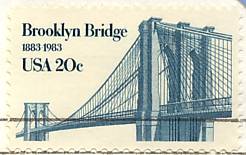 Brooklyn Bridge
|
|
Why did Canada feature a farm tractor on a stamp. (Unitrade catalog number 1552a). In the era that this Cockshutt 30 tractor was produced there were lots of tractors from many company's. What made this tractor worthy of being on a stamp. Well it has to do with a Canadian invention that helped change farming. It was the first tractor to have a live PTO, a Canadian invention. Your first question is probably what the heck is a PTO. PTO stands for power take off. On the back of a tractor is a splined output shaft. You can use this shaft to give power to a piece of farm equipment towed behind the tractor. Before live PTO the tractor had to be moving to power the equipment. Live PTO put an extra shaft in the power train to run the towed equipment. This allowed you run the PTO shaft with out the tractor moving. As an example of how this is useful, consider baling hay. While going down the field the baler picks up hay and makes bales. If the row you are working on has large clumps of hay that would clog the baler and break something, you can stop the forward motion of the baler and take in smaller amounts of hay, so you do not break the baler. The live PTO also allowed you to run things like saws to cut you fire wood. This made a tractor much more useful around the farm as a power source for lots of equipment that before the live PTO had to have its own engine.
|
 Cockshutt Model 30
|
|
Rudolph Diesel (1858-1913) developed a theory that revolutionized the engines of his day. He envisioned an engine in which air is
compressed to such a degree that there is an extreme rise in temperature. When fuel is injected into the piston chamber with this air,
the fuel is ignited by the high temperature of the air, exploding it, forcing the piston down. No spark plugs or other ignition hardware
needed for a gasoline engine. Diesel designed his engine in response to the heavy resource consumption and inefficiency of the steam
engine, which only produced 12% efficiency.
|
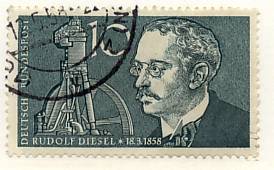 Rudolph Diesel |
|
Albert Einstein (March 14, 1879 April 18, 1955, born to a family of Jewish ancestry in Ulm, Wurttemberg, Germany) was a theoretical physicist widely considered one of the greatest physicists of all time. He formulated the special and general theories of relativity. In addition, he made significant advancements to quantum theory and statistical mechanics. While best known for the Theory of Relativity (and specifically mass-energy equivalence, E=mc2), he was awarded the 1921 Nobel Prize for Physics for his 1905 (his "wonderful year" or "miraculous year") explanation of the photoelectric effect and "for his services to Theoretical Physics". In popular culture, the name "Einstein" has become synonymous with great intelligence and genius.
Among his many investigations were: capillary action, his special theory of relativity which stemmed from an attempt to reconcile
the laws of mechanics with the laws of the electromagnetic field, his general theory of relativity which extended the principle
of relativity to include gravitation, relativistic cosmology, critical opalescence, classical problems of statistical mechanics
and problems in which they were merged with quantum theory, including an explanation of Brownian motion; atomic transition probabilities,
the probabilistic interpretation of quantum theory, the quantum theory of a monatomic gas, the thermal properties of light with a low
radiation density which laid the foundation of the photon theory of light, the theory of radiation, including stimulated emission;
the construction of a unified field theory, and the geometrization of physics.
|
 Albert Einstein |
|
By 1848, when the St. Lawrence canals could take ships of 200 feet in length and nine feet draft, steamboating was becoming big
business. Between Montreal and Lake Ontario, passenger steamers saved time by shooting the rapids downstream before returning up
stream by canal. The Royal Mail Line, then prominent in that trade, foresaw the advantages of iron construction and ordered the
side wheel paddler Passport from Scotland, where Clyde shipbuilders had been forward thinking by turning out do it yourself kits.
The Passport was launched in 1846 at Kingston, Ontario, where she had arrived as preformed plates and angles (painted red or green
and numbered accordingly), with hundreds of bags of rivets and scores of boxes containing machinery and bits and pieces. The new iron
paddler had upper and lower saloons, a dining room and private cabins for those who could afford the luxury. Even for less affluent travellers, who merely camped on deck with their own provisions, the run of 33 hours from Hamilton to Montreal with out transshipment was something to talk about. In those days, when railways were embryonic and road transport nonexistent, steamboats were regarded in much the same way as we see air transportation. In 1857 the Royal Mail Line became the Canadian Navigation Company. This joined with others in 1875 to form the Richelieu and Ontario Navigation Company. With Sir Hugh Allan of Montreal as Chairman, the R&0 was pre-eminent along the 800-mile route from Toronto to the Saguenay. The R&0 prospered as such until 1913, when it absorbed four competitors and a number of subsidiaries to become the Canada Steamship Lines (CSL) group. Following a complete rebuilding in 1901, the Passport emerged as the Caspian and sailed under the CSL flag until 1920. In that year she was sold to Alphonse A. Laroque of Montreal, finally disappearing from the register in 1929. It had been a remarkable career of at least three-quarters of a century.
|
 Steamship Passport |